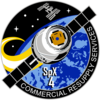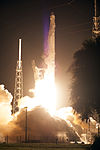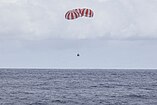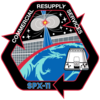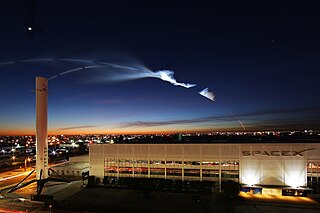
Space Exploration Technologies Corp., trading as SpaceX, is an American aerospace manufacturer and space transportation services company headquartered in Hawthorne, California. It was founded in 2002 by Elon Musk with the goal of reducing space transportation costs to enable the colonization of Mars. SpaceX has developed several launch vehicles, the Starlink satellite constellation, and the Dragon spacecraft. It is widely considered among the most successful private spaceflight companies.

The SpaceX Dragon, also known as Dragon 1 or Cargo Dragon and now superseded by Dragon 2, is a reusable cargo spacecraft developed by SpaceX, an American private space transportation company. Dragon was launched into orbit by the company's Falcon 9 launch vehicle to resupply the International Space Station (ISS).

Commercial Resupply Services (CRS) are a series of flights awarded by NASA for the delivery of cargo and supplies to the International Space Station (ISS) on commercially operated spacecraft. The first CRS contracts were signed in 2008 and awarded $1.6 billion to SpaceX for twelve cargo Dragon and $1.9 billion to Orbital Sciences for eight Cygnus flights, covering deliveries to 2016. The Falcon 9 and Antares rockets were also developed under the CRS program.

SpaceX CRS-3, also known as SpX-3, was a Commercial Resupply Service mission to the International Space Station, contracted to NASA, which was launched on 18 April 2014. It was the fifth flight for SpaceX's uncrewed Dragon cargo spacecraft and the third SpaceX operational mission contracted to NASA under a Commercial Resupply Services contract.

SpaceX CRS-8, also known as SpX-8, was a Commercial Resupply Service mission to the International Space Station (ISS) which was launched on April 8, 2016, at 20:43 UTC. It was the 23rd flight of a Falcon 9 rocket, the tenth flight of a Dragon cargo spacecraft and the eighth operational mission contracted to SpaceX by NASA under the Commercial Resupply Services program. The capsule carried over 3,100 kilograms (6,800 lb) of cargo to the ISS including the Bigelow Expandable Activity Module (BEAM), a prototype inflatable space habitat delivered in the vehicle's trunk, which will be attached to the station for two years of in-orbit viability tests.

SpaceX CRS-4, also known as SpX-4, was a Commercial Resupply Service mission to the International Space Station, contracted to NASA, which was launched on 21 September 2014 and arrived at the space station on 23 September 2014. It was the sixth flight for SpaceX's uncrewed Dragon cargo spacecraft, and the fourth SpaceX operational mission contracted to NASA under a Commercial Resupply Services contract. The mission brought equipment and supplies to the space station, including the first 3D printer to be tested in space, a device to measure wind speed on Earth, and small satellites to be launched from the station. It also brought 20 mice for long-term research aboard the ISS.

SpaceX CRS-6, also known as SpX-6, was a Commercial Resupply Service mission to the International Space Station, contracted to NASA. It was the eighth flight for SpaceX's uncrewed Dragon cargo spacecraft and the sixth SpaceX operational mission contracted to NASA under a Commercial Resupply Services contract. It was docked to the International Space Station from 17 April to 21 May 2015.

SpaceX CRS-11, also known as SpX-11, was a Commercial Resupply Service mission to the International Space Station, launched successfully on 3 June 2017. The mission was contracted by NASA and was flown by SpaceX. The mission utilized a Falcon 9 launch vehicle and was the first reuse of C106, a CRS Dragon cargo vessel that was previously flown on the CRS-4 mission.

SpaceX CRS-12, also known as SpX-12, was a Commercial Resupply Services mission to the International Space Station launched on 14 August 2017. The mission was contracted by NASA and was flown by SpaceX using a new Dragon capsule. The Falcon 9 rocket's reusable first stage performed a controlled landing on Landing Zone 1 (LZ1) at Cape Canaveral Air Force Station. After delivering more than 2,900 kilograms (6,400 lb) of cargo, the Dragon spacecraft returned to Earth on 17 September 2017.

SpaceX CRS-13, also known as SpX-13, was a Commercial Resupply Service mission to the International Space Station launched on 15 December 2017. The mission was contracted by NASA and is flown by SpaceX. It was the second mission to successfully reuse a Dragon capsule, previously flown on CRS-6. The first stage of the Falcon 9 Full Thrust rocket was the previously flown, "flight-proven" core from CRS-11. The first stage returned to land at Cape Canaveral's Landing Zone 1 after separation of the first and second stage.

SpaceX CRS-14, also known as SpX-14, was a Commercial Resupply Service mission to the International Space Station launched on 2 April 2018. The mission was contracted by NASA and was flown by SpaceX. This mission reused the Falcon 9 first stage booster previously flown on CRS-12 and the Dragon capsule flown on CRS-8.

SpaceX CRS-15, also known as SpX-15, was a Commercial Resupply Service mission to the International Space Station launched 29 June 2018 aboard a Falcon 9 rocket. The mission was contracted by NASA and flown by SpaceX.

SpaceX CRS-16, also known as SpX-16, was a Commercial Resupply Service mission to the International Space Station launched on 5 December 2018 aboard a Falcon 9 rocket. The mission was contracted by NASA and is flown by SpaceX.

SpaceX CRS-19, also known as SpX-19, was a Commercial Resupply Service mission to the International Space Station. The mission is contracted by NASA and was flown by SpaceX on a Falcon 9 rocket.
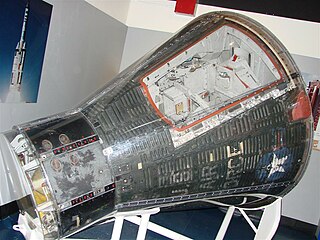
Gemini spacecraft No. 2 was the second NASA Project Gemini full-up space capsule built. This McDonnell Gemini capsule was the first spacecraft to be reused, flying twice into suborbital space. No.2 flew on missions Gemini-Titan 2 and Manned Orbiting Laboratory Gemini-B flight. The capsule is currently on display at the Air Force Space and Missile Museum at Cape Canaveral Air Force Station on the Space Coast of Florida, United States.

The SpaceX Dragon C108 is a Cargo Dragon space capsule built by SpaceX. It is the first Dragon capsule to be flown three times, having its third launch in 2019. C108 was first used on CRS-6, and then used again for the CRS-13 and CRS-18 missions. This third reuse of the spacecraft marks a milestone in SpaceX's drive to reduce space launch costs through reusing hardware.

SpaceX CRS-21, also known as SpaceX-21, is a Commercial Resupply Service mission to the International Space Station planned to be launched on 30 October 2020. The mission is contracted by NASA and will be flown by SpaceX using a Cargo Dragon. This will be the first flight for SpaceX under NASA's CRS-2 contract awarded in January 2016.

Crew Dragon Endeavour is a Crew Dragon spacecraft C206 manufactured and operated by SpaceX and used by NASA's Commercial Crew Program. It was launched into orbit on top of a Falcon 9 rocket on 30 May 2020 and successfully docked to the International Space Station (ISS) on 31 May 2020 as part of the Crew Dragon Demo-2 mission. It was the first crewed flight test of Dragon capsule, carrying Douglas Hurley and Robert Behnken. It is the spacecraft used in the first crewed orbital spaceflight from the United States since STS-135 in July 2011 and the first crewed orbital spaceflight by a private company. As of June 2020, the spacecraft is docked to the ISS. It is expected to return to Earth in August. The spacecraft was named by Hurley and Behnken after the Space Shuttle Endeavour, the spacecraft the both of them first flew on, respectively on missions STS-127 and STS-123.

